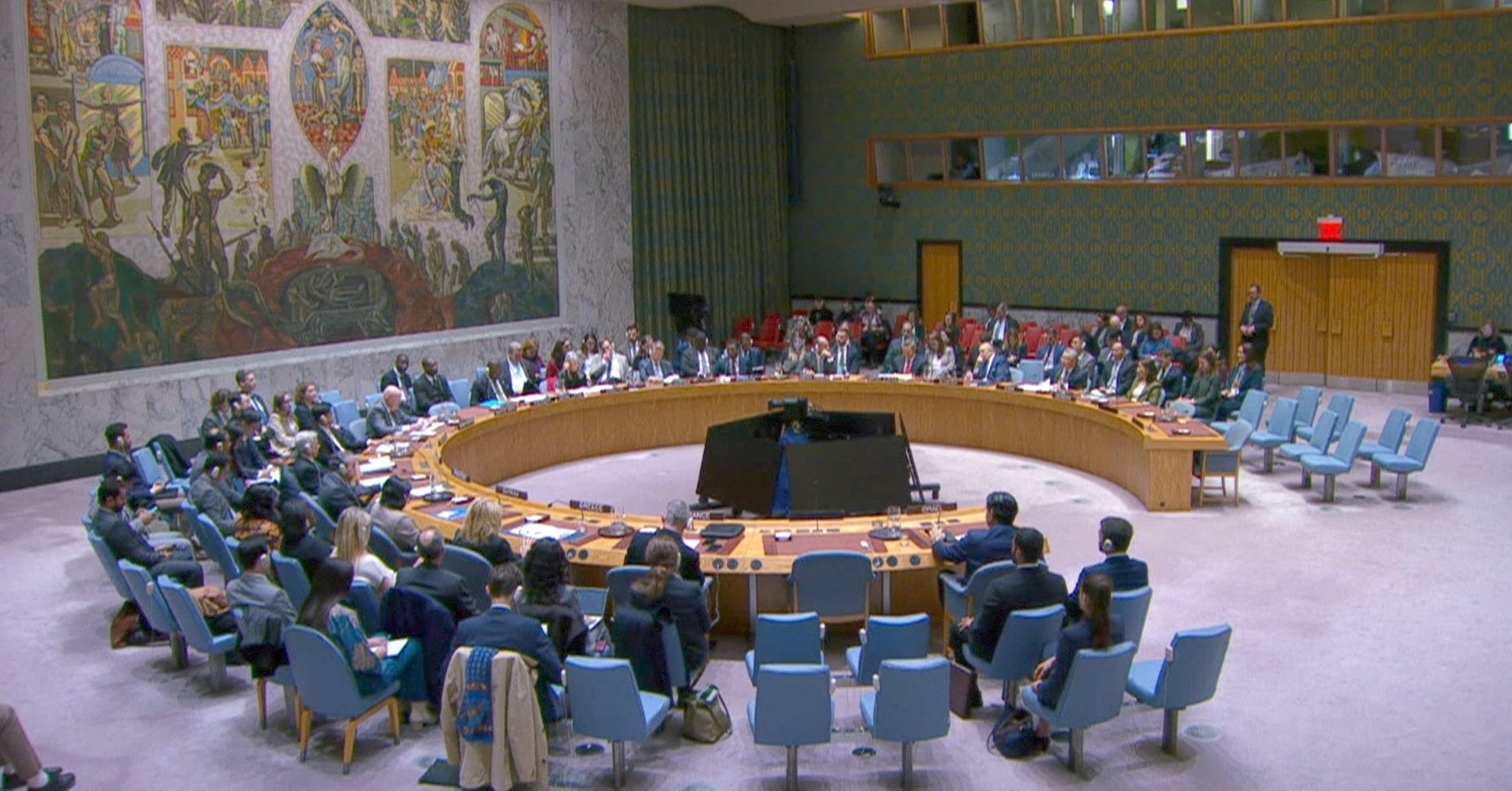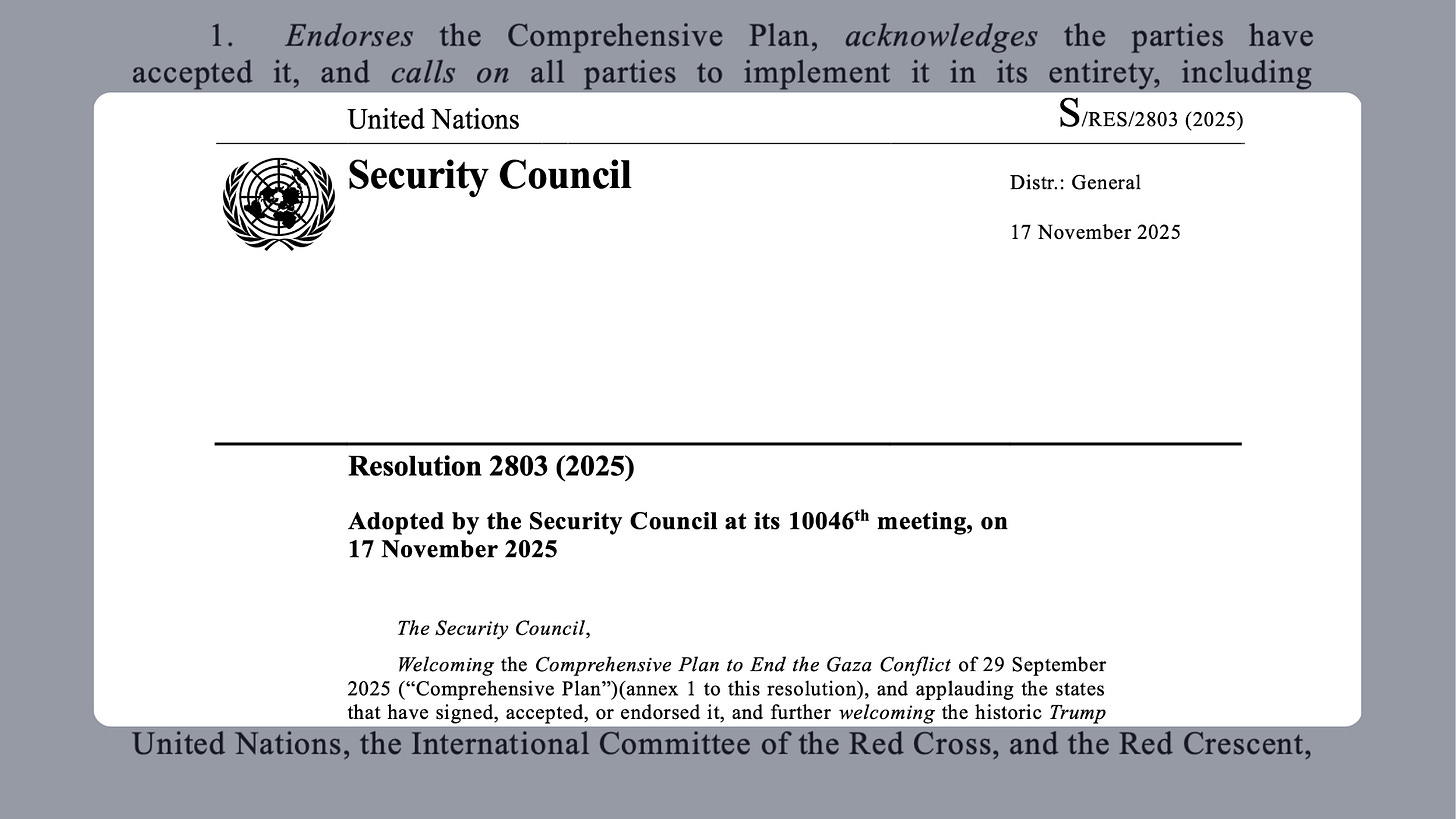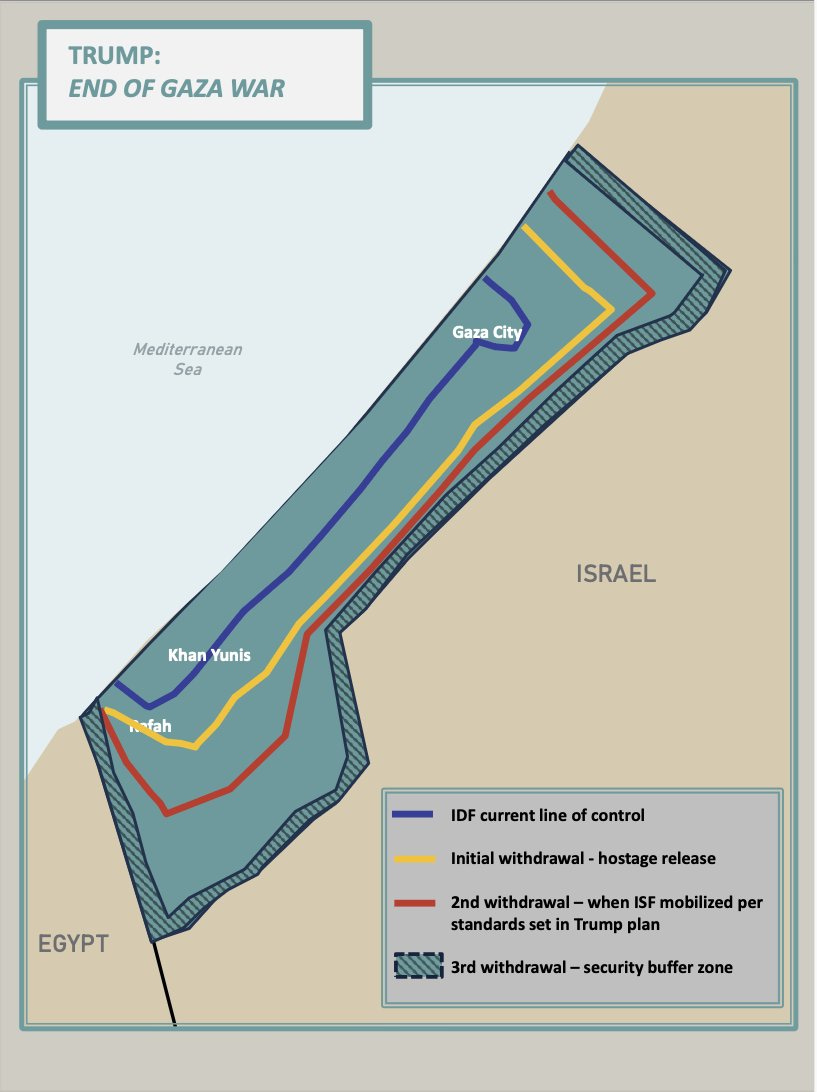UN Security Council backs Trump's plan for 'New Gaza': What's in the resolution?
Read the full text of UN Security Council Resolution 2803 and President Donald J. Trump’s Comprehensive Plan to End the Gaza Conflict
Late on November 17, the UN Security Council voted in favour of a resolution based on the U.S.-drafted 20-point plan for a post-war Gaza.
The headlines include some of the next steps for the Gaza Strip, after the plan’s initial phase was used to broker a ceasefire last month that slowed the large-scale fighting and casualties taking place in the territory.
The resolution was supported by 13 countries on the UN Security Council, and did not receive any votes against — although Russia and China abstained. Russia cited concern that the document could become “a death warrant for the two-state solution”, while China said it was vague and lacking detail on critical elements.
The plan includes provisions for the establishment of an International Stabilisation Force (ISF) to operate within Gaza. The U.S. has said that multiple countries have offered to contribute troops, although these countries have not yet been named. News reports suggested that the U.S. is aiming to deploy the first ISF troops in January 2026.
A spokesperson for UN Secretary-General António Guterres said in a statement that the adoption of the resolution was “an important step in the consolidation of the ceasefire”.
“It is essential now to translate the diplomatic momentum into concrete and urgently needed steps on the ground. The United Nations is committed to implementing the roles entrusted to it in the resolution, scaling up humanitarian assistance to meet the needs of civilians in Gaza and supporting all efforts to move the parties toward the next phase of the ceasefire.”
The resolution, which paves the way for foreign troops in the enclave, has been rejected by Hamas, which stated that it “imposes an international guardianship mechanism on the Gaza Strip, which our people and their factions reject”.
In a statement on Telegram, the Palestinian group wrote: “Assigning the international force with tasks and roles inside the Gaza Strip, including disarming armed groups, strips it of its neutrality, and turns it into a party to the conflict in favour of Israeli forces.”
Hamas has governed the Gaza Strip since 2007, but the 20-point plan, proposed by U.S. President Donald Trump, specifies that Hamas members must disarm or leave Gaza, and they and other factions must not play any role in the governance of the territory. The Palestinian Authority welcomed the adoption of the resolution.
There are a number of other key events that are stipulated by the original U.S. plan. The ‘Board of Peace’ — a transitional governance body — will be established to supervise the future activities in the strip, including the delivery of aid and reconstruction work. The plan proposes that funding for the construction effort would come from a trust fund established by the World Bank and other financial institutions.

But what else is in it? The 20-point plan was published by the White House on September 29, and the first phase of it was ultimately signed on October 9. The latest UN Security Council resolution endorses that plan and adds some more context on the next steps.
Read the full text of both below.
Full text of UN Security Council Resolution 2803 (2025)
Resolution 2803 (2025)
Adopted by the Security Council at its 10046th meeting, on 17 November 2025
The Security Council,
Welcoming the Comprehensive Plan to End the Gaza Conflict of 29 September 2025 (“Comprehensive Plan”)(annex 1 to this resolution), and applauding the states that have signed, accepted, or endorsed it, and further welcoming the historic Trump Declaration for Enduring Peace and Prosperity of 13 October 2025 and the constructive role played by the United States of America, the State of Qatar, the Arab Republic of Egypt, and the Republic of Türkiye, in having facilitated the ceasefire in the Gaza Strip,
Determining that the situation in the Gaza Strip threatens the regional peace and the security of neighboring states and noting prior relevant Security Council resolutions relating to the situation in the Middle East, including the Palestinian question,
Endorses the Comprehensive Plan, acknowledges the parties have accepted it, and calls on all parties to implement it in its entirety, including maintenance of the ceasefire, in good faith and without delay;
Welcomes the establishment of the Board of Peace (BoP) as a transitional administration with international legal personality that will set the framework, and coordinate funding for, the redevelopment of Gaza pursuant to the Comprehensive Plan, and in a manner consistent with relevant international legal principles, until such time as the Palestinian Authority (PA) has satisfactorily completed its reform program, as outlined in various proposals, including President Trump’s peace plan in 2020 and the Saudi-French Proposal, and can securely and effectively take back control of Gaza. After the PA reform program is faithfully carried out and Gaza redevelopment has advanced, the conditions may finally be in place for a credible pathway to Palestinian self-determination and statehood. The United States will establish a dialogue between Israel and the Palestinians to agree on a political horizon for peaceful and prosperous coexistence;
Underscores the importance of the full resumption of humanitarian aid in cooperation with the BoP into the Gaza Strip in a manner consistent with relevant international legal principles and through cooperating organizations, including the United Nations, the International Committee of the Red Cross, and the Red Crescent, and ensuring such aid is used solely for peaceful uses and not diverted by armed groups;
Authorizes Member States participating in the BoP and the BoP to: (A) enter into such arrangements as may be necessary to achieve the objectives of the Comprehensive Plan, including those addressing privileges and immunities of personnel of the force established in paragraph 7 below; and (B) establish operational entities with, as necessary, international legal personality and transactional authorities for the performance of its functions, including: (1) the implementation of a transitional governance administration, including the supervising and supporting of a Palestinian technocratic, apolitical committee of competent Palestinians from the Strip, as championed by the Arab League, which shall be responsible for day -to-day operations of Gaza’s civil service and administration; (2) the reconstruction of Gaza and of economic recovery programs; (3) the coordination and supporting of and delivery of public services and humanitarian assistance in Gaza; (4) any measures to facilitate the movement of persons in and out of Gaza, in a manner consistent with the Comprehensive Plan; and (5) any such additional tasks as may be necessary to support and implement the Comprehensive Plan;
Understands that the operational entities referred to in paragraph 4 above will operate under the transitional authority and oversight of the BoP and are to be funded through voluntary contributions from donors and BoP funding vehicles and governments;
Calls upon the World Bank and other financial institutions to facilitate and provide financial resources to support the reconstruction and development of Gaza, including through the establishment of a dedicated trust fund for this purpose and governed by donors;
Authorizes Member States working with the BoP and the BoP to establish a temporary International Stabilization Force (ISF) in Gaza to deploy under unified command acceptable to the BoP, with forces contributed by participating States, in close consultation and cooperation with the Arab Republic of Egypt and the State of Israel, and to use all necessary measures to carry out its mandate consistent with international law, including international humanitarian law. The ISF shall work with Israel and Egypt, without prejudice to their existing agreements, along with the newly trained and vetted Palestinian police force, to help secure border areas; stabilize the security environment in Gaza by ensuring the process of demilitarizing the Gaza Strip, including the destruction and prevention of rebuilding of the military, terror, and offensive infrastructure, as well as the permanent decommissioning of weapons from non-state armed groups; protect civilians, including humanitarian operations; train and provide support to the vetted Palestinian police forces; coordinate with relevant States to secure humanitarian corridors; and undertake such additional tasks as may be necessary in support of the Comprehensive Plan. As the ISF establishes control and stability, the Israel Defense Forces (IDF) will withdraw from the Gaza Strip based on standards, milestones, and timeframes linked to demilitarization that will be agreed between the IDF, ISF, the guarantors, and the United States, save for a security perimeter presence that will remain until Gaza is properly secure from any resurgent terror threat. The ISF shall, (A) assist the BoP in monitoring the implementation of the ceasefire in Gaza, and enter into such arrangements as may be necessary to achieve the objectives of the Comprehensive Plan; and (B) operate under the strategic guidance of the BoP and will be funded through voluntary contributions from donors and BoP funding vehicles and governments;
Decides the BoP and international civil and security presences authorized by this resolution shall remain authorized until Dec. 31, 2027, subject to further action by the Council, and any further reauthorization of the ISF be in full cooperation and coordination with Egypt and Israel and other Member States continuing to work with the ISF;
Calls upon Member States and international organizations to work with the BoP to identify opportunities to contribute personnel, equipment, and financial resources to its operating entities and the ISF, to provide technical assistance to its operating entities and the ISF, and to give full recognition to its acts and documents;
Requests the BoP provide a written report on progress related to the above to the UN Security Council every six months;
Decides to remain seized of the matter.
President Donald J. Trump’s Comprehensive Plan to End the Gaza Conflict
Gaza will be a deradicalized terror-free zone that does not pose a threat to its neighbors.
Gaza will be redeveloped for the benefit of the people of Gaza, who have suffered more than enough.
If both sides agree to this proposal, the war will immediately end. Israeli forces will withdraw to the agreed upon line to prepare for a hostage release. During this time, all military operations, including aerial and artillery bombardment, will be suspended, and battle lines will remain frozen until conditions are met for the complete staged withdrawal.
Within 72 hours of Israel publicly accepting this agreement, all hostages, alive and deceased, will be returned.
Once all hostages are released, Israel will release 250 life sentence prisoners plus 1700 Gazans who were detained after October 7th 2023, including all women and children detained in that context. For every Israeli hostage whose remains are released, Israel will release the remains of 15 deceased Gazans.
Once all hostages are returned, Hamas members who commit to peaceful co-existence and to decommission their weapons will be given amnesty. Members of Hamas who wish to leave Gaza will be provided safe passage to receiving countries.
Upon acceptance of this agreement, full aid will be immediately sent into the Gaza Strip. At a minimum, aid quantities will be consistent with what was included in the January 19, 2025, agreement regarding humanitarian aid, including rehabilitation of infrastructure (water, electricity, sewage), rehabilitation of hospitals and bakeries, and entry of necessary equipment to remove rubble and open roads.
Entry of distribution and aid in the Gaza Strip will proceed without interference from the two parties through the United Nations and its agencies, and the Red Crescent, in addition to other international institutions not associated in any manner with either party. Opening the Rafah crossing in both directions will be subject to the same mechanism implemented under the January 19, 2025 agreement.
Gaza will be governed under the temporary transitional governance of a technocratic, apolitical Palestinian committee, responsible for delivering the day-to-day running of public services and municipalities for the people in Gaza. This committee will be made up of qualified Palestinians and international experts, with oversight and supervision by a new international transitional body, the “Board of Peace,” which will be headed and chaired by President Donald J. Trump, with other members and heads of State to be announced, including Former Prime Minister Tony Blair. This body will set the framework and handle the funding for the redevelopment of Gaza until such time as the Palestinian Authority has completed its reform program, as outlined in various proposals, including President Trump’s peace plan in 2020 and the Saudi-French proposal, and can securely and effectively take back control of Gaza. This body will call on best international standards to create modern and efficient governance that serves the people of Gaza and is conducive to attracting investment.
A Trump economic development plan to rebuild and energize Gaza will be created by convening a panel of experts who have helped birth some of the thriving modern miracle cities in the Middle East. Many thoughtful investment proposals and exciting development ideas have been crafted by well-meaning international groups, and will be considered to synthesize the security and governance frameworks to attract and facilitate these investments that will create jobs, opportunity, and hope for future Gaza.
A special economic zone will be established with preferred tariff and access rates to be negotiated with participating countries.
No one will be forced to leave Gaza, and those who wish to leave will be free to do so and free to return. We will encourage people to stay and offer them the opportunity to build a better Gaza.
Hamas and other factions agree to not have any role in the governance of Gaza, directly, indirectly, or in any form. All military, terror, and offensive infrastructure, including tunnels and weapon production facilities, will be destroyed and not rebuilt. There will be a process of demilitarization of Gaza under the supervision of independent monitors, which will include placing weapons permanently beyond use through an agreed process of decommissioning, and supported by an internationally funded buy back and reintegration program all verified by the independent monitors. New Gaza will be fully committed to building a prosperous economy and to peaceful coexistence with their neighbors.
A guarantee will be provided by regional partners to ensure that Hamas, and the factions, comply with their obligations and that New Gaza poses no threat to its neighbors or its people.
The United States will work with Arab and international partners to develop a temporary International Stabilization Force (ISF) to immediately deploy in Gaza. The ISF will train and provide support to vetted Palestinian police forces in Gaza, and will consult with Jordan and Egypt who have extensive experience in this field. This force will be the long-term internal security solution. The ISF will work with Israel and Egypt to help secure border areas, along with newly trained Palestinian police forces. It is critical to prevent munitions from entering Gaza and to facilitate the rapid and secure flow of goods to rebuild and revitalize Gaza. A deconfliction mechanism will be agreed upon by the parties.
Israel will not occupy or annex Gaza. As the ISF establishes control and stability, the Israel Defense Forces (IDF) will withdraw based on standards, milestones, and timeframes linked to demilitarization that will be agreed upon between the IDF, ISF, the guarantors, and the Unites States, with the objective of a secure Gaza that no longer poses a threat to Israel, Egypt, or its citizens. Practically, the IDF will progressively hand over the Gaza territory it occupies to the ISF according to an agreement they will make with the transitional authority until they are withdrawn completely from Gaza, save for a security perimeter presence that will remain until Gaza is properly secure from any resurgent terror threat.
In the event Hamas delays or rejects this proposal, the above, including the scaled-up aid operation, will proceed in the terror-free areas handed over from the IDF to the ISF.
An interfaith dialogue process will be established based on the values of tolerance and peaceful co-existence to try and change mindsets and narratives of Palestinians and Israelis by emphasizing the benefits that can be derived from peace.
While Gaza re-development advances and when the PA reform program is faithfully carried out, the conditions may finally be in place for a credible pathway to Palestinian self-determination and statehood, which we recognize as the aspiration of the Palestinian people.
The United States will establish a dialogue between Israel and the Palestinians to agree on a political horizon for peaceful and prosperous co-existence.
SOURCES
United Nations Security Council. Resolution 2803 (2025) Adopted by the Security Council at its 10046th meeting, on 17 November 2025.
X (formerly Twitter). (2025). Available at: President Donald J. Trump’s Comprehensive Plan to End the Gaza Conflict, Sept. 29. [Accessed 18 Nov. 2025].
Secretary-General. (2025). Note to Correspondents: on the adoption of the resolution on Gaza by the Security Council. [online] [Accessed 18 Nov. 2025].
X (formerly Twitter). (2025). Available at: #BREAKING UN Security Council ADOPTS resolution authorizing a Board of Peace and an International Stabilization Force in #Gaza, as outlined in a United States “Comprehensive Plan to End the Gaza Conflict”. [Accessed 18 Nov. 2025].
Ravid, B. (2025). Scoop: U.S. seeks UN approval for Gaza security force with broad two-year mandate. [online] Axios. [Accessed 18 Nov. 2025].





